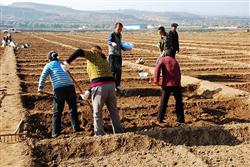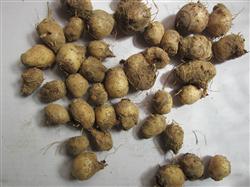Planting techniques of Pinellia ternata: how to plant Pinellia ternata to achieve high yield?

In previous years, the yield of planting Pinellia ternata has not been high, how to plant Pinellia ternata to achieve high yield? Also ask experienced friends to help introduce planting methods to plant Pinellia ternata in order to obtain good yield, you can refer to the following methods: first, choose high-quality geological planting: the tubers of Pinellia ternata growing in the soil have more stringent geological requirements. It is afraid of both acid and alkali, sand and slime, which requires fertile soil and restricts the use of chemical fertilizer. The soil is wet in the early stage and dry in the later stage. Because of the four contradictory characteristics of the soil caused by the growth of Pinellia ternata, the land planted with Pinellia ternata should choose sandy soil with moist and fertile soil, strong water and fertility conservation, loose texture, good drainage and irrigation and neutral reaction. it can also be planted in semi-shady and semi-sunny hilly areas and forests and orchards with certain light conditions. The geology should be consistent with: the pH value is between 6.5 and 7.5, the sand is not sticky, and the content of organic matter should be more than 1.2. Method 2. The choice of planting topography: the choice of topography is often the most easily ignored problem for Pinellia ternata growers, which is generally considered to be unimportant. in fact, for Pinellia ternata planting, the reasonable choice of topography is directly related to the high quality and high yield of Pinellia ternata. The topography of the planting land of Pinellia ternata should be achieved: in the low mountains and mountains, the gentle slopes of half shade and half sun should be selected, and the slope between 10 degrees and 30 degrees is the best; for planting Pinellia ternata in plain areas, it is necessary to choose plots that can be irrigated and the terrain is high. Be sure to make a good drainage ditch before planting. In addition, the surrounding environment should be investigated on the spot, there is no pollution source within 1000 meters, more than 100m away from the main road, the irrigation water used should meet the national farmland irrigation water standards. The correct and reasonable selection of topography is the basis of high yield of Pinellia ternata, and we must not be careless. Method 3. Select excellent varieties of Pinellia ternata: because the artificial cultivation of Pinellia ternata began in the mid-1980s for a short time, coupled with the influence of the characteristics, price and other factors of Pinellia ternata, so far, there are no good varieties that have been formally approved by the state. The leaf types of Pinellia ternata can be divided into bamboo leaf type, bamboo leaf type, willow leaf type (called "narrow clover" by the author), apricot leaf type, palm leaf type and so on. Bamboo leaf type and apricot leaf type are widely distributed and have been found in the main producing areas of Pinellia ternata in China; similar bamboo leaf type and palm leaf type are distributed in some areas of Guizhou, Yunnan, Sichuan, Hunan, Jiangxi and other provinces and the Yangtze River basin; the main origin of "narrow clover" Pinellia ternata is Shandong. Compared and screened from the different leaf types of Pinellia ternata, the "narrow clover" Pinellia ternata from Heze, Shandong Province and Fengxian County, Jiangsu Province has the highest yield, better quality, vigorous growth, more tillers, large and thick leaves, strong photosynthesis and resistance, early and more bulbous buds, large and round commodity individuals, which is an excellent variety of Pinellia ternata. Method 4. Selection of seed soaking agents: the diseases and insect pests of artificially cultivated Pinellia ternata are mainly prevented and supplemented by treatment. once a large area of diseases and insect pests occur in the growing period, it is very troublesome to treat them, which not only affects the growth of Pinellia ternata, but also easy to produce pesticide residues at the same time. It also increases the planting cost, so it is very important to treat the seed stem before sowing. However, in the medicament selection, dosage and method of soaking and mixing the seed stem, it is necessary to correctly select the germicidal and seed dressing agents with high efficiency, low toxicity and low residue; the dosage and treatment methods should be scientific, reasonable and appropriate, and must not be used indiscriminately or indiscriminately, so as not to cause unnecessary losses. Method 5. Selection of planting time: Pinellia ternata can grow in most provinces of our country. In order to maximize the growth time and improve the yield and quality of Pinellia ternata, the best sowing time should be selected according to different areas. The southern provinces with short frost and frost periods can be cultivated in late autumn or winter; the optimum planting time in Huang-Huai region is from late February to early March (from Rain Water to sting); and the planting time in some areas of northwest and northeast can be postponed appropriately. In a word, the most suitable planting time of Pinellia ternata in various provinces and regions, the underground temperature in 5cm is stable at 5 ℃ ~ 7 ℃, which is the best sowing time. Sowing as early as possible and taking effective measures can make the petiole of Pinellia ternata grow horizontally and grow bulbs in the soil, form large globules in the soil, quickly take root and sprout, form a new plant, and increase the propagation coefficient, which is one of the important technical measures for high-yield cultivation of Pinellia ternata. Methods the planting method of Pinellia ternata was to open a horizontal trench to sow on the prepared sowing border. When the graded large and small seed stems were sown separately, the row spacing of the first class seed stem was thinner (30cm) and the sowing depth was deeper (7~9cm); in turn, the fourth grade seed stem row spacing was thicker (15cm) and the planting was shallow (3~4cm). After sowing, a layer of mixed fertilizer soil is applied above, which is evenly mixed with rotten compost and stable manure plus human and animal fertilizer, grass soil ash, etc., and the final covering soil can be less below the ground (semi-mechanized sowing can also be used, which can be completed at one time, which can improve the efficiency by 80%). As there are many weeds during the growth period of Pinellia ternata, especially in the seedling stage, only weeds can not be seen. Therefore, after the sowing of Pinellia ternata is completed, the special herbicide of Pinellia ternata is sprayed immediately and covered with plastic film immediately, which can effectively control the harm of weeds, especially 100% of Gramineae weeds. To be sprayed with herbicide should be immediately covered with plastic film, the film can be ordinary agricultural plastic film (thick 0.014mm), can also use high-density plastic film (0.008mm). The width of plastic film depends on the width of the bed. Click to get more planting techniques of Pinellia ternata
- Prev

Planting techniques of Pinellia ternata: what are the diseases and insect pests of Pinellia ternata?
What are the diseases and insect pests of Pinellia ternata? How to control diseases and insect pests in Pinellia ternata? Ask netizens to help introduce the diseases and insect pests of Pinellia ternata, such as root rot, virus disease and red diamondback moth; detailed control methods can be listed below: 1. Root rot harm and control methods: root rot is easy to occur in high temperature season and stagnant water in the field.
- Next

Planting technique of Pinellia ternata: how to deal with the seeds of Pinellia ternata?
How to deal with the seeds of Pinellia ternata before sowing? I hope you can help introduce the need to treat the seeds before sowing Pinellia ternata, which can effectively control diseases and insect pests, improve the germination rate, and play an important role in the quality, integrity and strength of seedlings, which is the primary prerequisite for stable and high yield. Generally, the yield can be increased by 5% and 20%. Before the seeds of Pinellia ternata are sown.
Related
- Fuxing push coffee new agricultural production and marketing class: lack of small-scale processing plants
- Jujube rice field leisure farm deep ploughing Yilan for five years to create a space for organic food and play
- Nongyu Farm-A trial of organic papaya for brave women with advanced technology
- Four points for attention in the prevention and control of diseases and insect pests of edible fungi
- How to add nutrient solution to Edible Fungi
- Is there any good way to control edible fungus mites?
- Open Inoculation Technology of Edible Fungi
- Is there any clever way to use fertilizer for edible fungus in winter?
- What agents are used to kill the pathogens of edible fungi in the mushroom shed?
- Rapid drying of Edible Fungi

